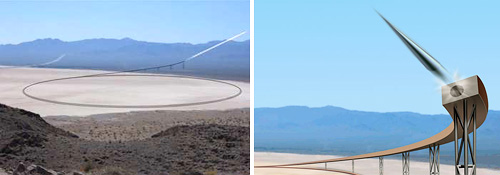
By Andrew Liszewski
Launching stuff into space would be quite a bit easier if it wasn’t for this pesky gravity we have to deal with. This is one of the biggest reasons a space station is an important next step for space travel since it’s far easier to launch a craft that’s already in orbit.
But that’s still a few years away which is why companies are still looking for cheaper ways to get things like satellites into orbit. LaunchPoint Technologies recently received $500,000 from the US Air Force to further develop an idea they have for a launch system using magnetic levitation technology. Basically the design has a payload of up to 220lbs being accelerated around a giant ring using magnets up to a speed of about six miles per second. (The payload would be facing about 10,000 Gs of force, most people pass out at 3.) When it reaches this speed it would then be routed to a launch ramp where it basically gets hurled into orbit.
The biggest advantage to this system is of course the cost. The first magnetic launch systems are expected to only cost about $750 / lb. Considering current rocket based systems run about $4,000 / lb it means I could finally get my home made satellite up in orbit. (It will be exclusively used for off-planet gambling.)
[ LaunchPoint Technologies Magnetic Satellite Launch System ] VIA [ Popular Science ]










